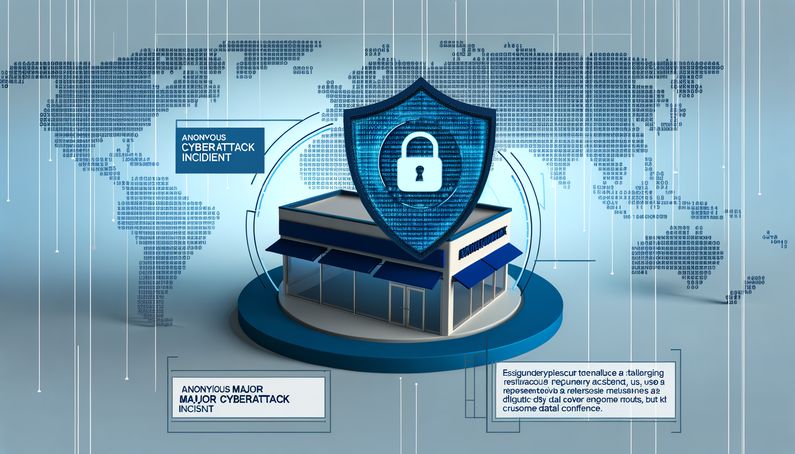
Cybersecurity Challenges in Retail: Lessons from the Harrods Attack
The recent cyberattack on Harrods highlights the critical cybersecurity challenges facing the retail sector. As a renowned department store, Harrods manages vast amounts of consumer data, making it an attractive target for cybercriminals. This incident is part of a worrying trend of breaches affecting major retailers like Marks & Spencer and the Co-op, underscoring the urgent need to protect consumer trust and business integrity. A Darktrace report indicates that the retail industry is particularly vulnerable to data breaches, which can severely damage a brand’s reputation and erode customer confidence. The financial stakes are high, with potential losses from fraudulent transactions and legal liabilities, as noted in a Shopify report. This analysis explores the broader implications of such cyberattacks on the retail sector, examining the challenges and strategic responses necessary to safeguard consumer data and maintain trust.
Broader Implications for the Retail Sector
Impact on Consumer Trust
The cyberattack on Harrods, along with similar incidents at Marks & Spencer and the Co-op, raises significant concerns about consumer trust in the retail sector. Retailers handle large volumes of personal and financial data, and breaches can severely damage their reputation. According to a Darktrace report, data breaches can lead to a substantial loss of customer trust, which is crucial in an industry reliant on consumer confidence. A single breach can tarnish a brand’s reputation, leading to long-term damage and potential loss of business and loyalty.
Financial Repercussions
Cyberattacks on retail businesses have profound financial implications. The theft of sensitive data can result in direct financial losses through fraudulent transactions and system downtime. Additionally, legal liabilities from failing to protect customer information can lead to costly lawsuits and regulatory penalties. The Shopify report highlights that the retail industry ranks among the top five most vulnerable to cybersecurity attacks, with significant financial stakes. These breaches can cripple a business, emphasizing the need for robust cybersecurity measures.
Regulatory and Legal Challenges
Retailers face increasing regulatory scrutiny following cyberattacks. Compliance with data protection regulations, such as the General Data Protection Regulation (GDPR) in Europe, is crucial. Non-compliance can result in hefty fines and legal challenges. The Darktrace report notes that legal liabilities associated with data breaches can lead to significant financial penalties. Retailers must ensure they have strong data security measures in place to comply with these regulations and protect customer information.
Technological Vulnerabilities
The adoption of digital technologies in retail has created new vulnerabilities that cybercriminals can exploit. As retailers increasingly use digital solutions to enhance customer experiences and streamline operations, they must also address associated cybersecurity risks. According to the Shopify report, cybercriminals are targeting not just credit card numbers but also sensitive personal data and the massive cash flows in ecommerce businesses. Retailers must invest in advanced cybersecurity technologies to protect their systems and data.
Strategic Responses and Solutions
Retailers must adopt strategic measures to enhance their cybersecurity posture in response to growing cyber threats. This includes implementing strong data security measures, such as encryption, regular security audits, and secure access protocols. The Darktrace report emphasizes the importance of these measures in protecting against data breaches. Additionally, retailers should invest in employee training to raise awareness about cybersecurity threats and foster a culture of security within the organization.
Industry Collaboration and Information Sharing
Collaboration and information sharing among retailers can play a crucial role in combating cyber threats. By sharing information about cyber threats and vulnerabilities, retailers can collectively enhance their cybersecurity defenses. Industry associations and cybersecurity organizations can facilitate this collaboration by providing platforms for information exchange and best practice sharing. The Shopify report highlights the importance of industry collaboration in addressing the cybersecurity challenges facing the retail sector.
Future Outlook and Trends
Looking ahead, the retail sector must remain vigilant in the face of evolving cyber threats. The Asimily report identifies system intrusion, web application attacks, and social engineering as significant threats to retail businesses. Retailers must stay informed about the latest cybersecurity trends and invest in technologies and strategies to protect their systems and data. As the retail industry continues to digitize, the importance of robust cybersecurity measures will only increase.
Role of Cybersecurity Insurance
Cybersecurity insurance is becoming an essential component of risk management for retailers. It provides financial protection against the costs associated with data breaches, including legal fees, regulatory fines, and remediation expenses. Retailers should consider investing in cybersecurity insurance as part of their broader risk management strategy. The Darktrace report notes that the financial consequences of data breaches can be severe, and insurance can help mitigate these risks.
Importance of Incident Response Planning
Having a well-defined incident response plan is critical for retailers to effectively manage and mitigate the impact of cyberattacks. An incident response plan outlines the steps to be taken in the event of a breach, including communication strategies, containment measures, and recovery processes. Retailers must regularly update and test their incident response plans to ensure they are prepared to respond swiftly and effectively to cyber threats. The Shopify report emphasizes the importance of incident response planning in minimizing the impact of cyberattacks.
Enhancing Customer Communication
Transparent and timely communication with customers is essential in the aftermath of a cyberattack. Retailers must inform affected customers about the breach, the steps being taken to address it, and any measures customers can take to protect themselves. Clear communication can help maintain customer trust and loyalty, even in the face of a breach. The Darktrace report highlights the importance of maintaining customer trust in the wake of data breaches.
Leveraging Artificial Intelligence and Machine Learning
Artificial intelligence (AI) and machine learning (ML) technologies offer significant potential for enhancing cybersecurity in the retail sector. These technologies can help detect and respond to cyber threats in real-time, identify patterns of suspicious activity, and automate threat response processes. Retailers should explore the use of AI and ML to strengthen their cybersecurity defenses and protect their systems and data from cyber threats. The Shopify report discusses the role of AI and ML in addressing the cybersecurity challenges facing the retail industry.
Building a Cybersecurity Culture
Creating a strong cybersecurity culture within the organization is essential for retailers to effectively combat cyber threats. This involves fostering a security-conscious mindset among employees, providing regular training on cybersecurity best practices, and encouraging employees to report suspicious activity. Retailers must prioritize cybersecurity at all levels of the organization and ensure that it is integrated into their overall business strategy. The Darktrace report emphasizes the importance of building a cybersecurity culture to protect against data breaches.
Conclusion
The cyberattack on Harrods highlights the broader implications for the retail sector and underscores the need for robust cybersecurity measures. Retailers must invest in advanced technologies, collaborate with industry peers, and foster a culture of security to protect their systems and data from cyber threats. By adopting a proactive approach to cybersecurity, retailers can mitigate the risks associated with data breaches and maintain consumer trust in an increasingly digital world.
Final Thoughts
The Harrods cyberattack underscores the urgent need for the retail sector to bolster its cybersecurity defenses. As digital transformation accelerates, retailers must prioritize robust security measures to protect sensitive data and maintain consumer trust. Collaborative efforts, such as industry-wide information sharing and adopting advanced technologies like AI and machine learning, are crucial in combating cyber threats. The Darktrace report emphasizes the importance of building a cybersecurity culture within organizations, while the Shopify report highlights the role of strategic planning and incident response in mitigating risks. By fostering a proactive approach to cybersecurity, retailers can navigate the complexities of the digital landscape and safeguard their businesses against future threats.
References
- Darktrace. (n.d.). Cybersecurity for retail & ecommerce. https://www.darktrace.com/cyber-ai-glossary/cybersecurity-for-retail-ecommerce
- Shopify. (n.d.). Retail cybersecurity. https://www.shopify.com/retail/retail-cybersecurity
- Asimily. (2023). 4 retail cyberattacks that hurt businesses. https://www.asimily.com/blog/4-retail-cyberattacks-that-hurt-businesses-2023/



